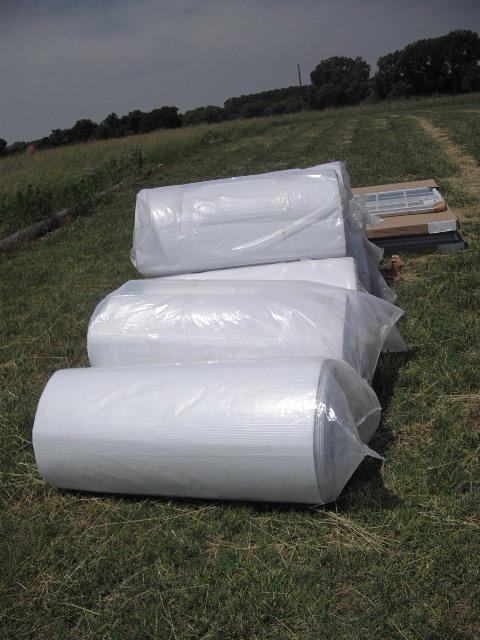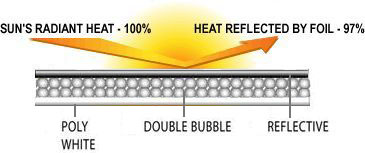
Double Bubble Insulation


Approximately 75% of total heat transfer in a residence or building occurs through radiation. Radiant Barriers and Reflective Insulation can reflect or block up to 97% of RADIANT HEAT from entering your residence or building's structure. (As illustrated above)
1.CONVECTION: Occurs with the physical movement of air. There are two types of convectional heat movement. The first is natural, where hot air rises displacing the cold air and moving it down. The second type is forced or mechanical convection which occurs when an object, like a fan, physically moves or forces the air to move.
2.CONDUCTION: Occurs in a solid or liquid when heat from one object is transferred by touch, to another object. An example of this occurs when a pot on a stove will heat up by conductive heat transfer from the coil.
3.RADIATION: Radiant heat transfer involves the transfer of energy through an empty space or void. Any object that is above absolute zero, will emit radiant heat to colder objects around it. The transfer of heat from the Sun is the best example of radiant heat flow. Although there is no matter in space, heat travels from the Sun to the Earth through radiation – or infrared waves. When these waves encounter an object, they can be either reflected or absorbed as heat. Highly reflective surfaces such as aluminum, are effective in stopping up to 97% of radiant heat transfer. With this in mind, it only makes sense to incorporate reflective insulation or radiant barriers, in any insulation system.
When installed correctly, radiant barrier and reflective insulations can dramatically reduce the overall heat transfer through your home or building. Because the majority of this heat transfer is radiant heat from the sun, it makes sense to utilize a radiant barrier or reflective insulation that will reflect up to 97% of that radiant heat. Traditional types of insulation such as fiberglass, foam and cellulose are effective insulators against convectional and conductive heat transfer. If up to 75% of your heat loss or heat gain is radiant, why not use a radiant barrier or reflective insulation that will reduce the radiant heat gain or loss by 97%? Radiant barrier and reflective insulations can do this for you easily and cost effectively.
What is the R-Value of Double Bubble Reflective Insulation?
R-Value indicates resistance to heat loss, and measures a mass insulation’s ability to slow down the transfer of heat. R-Values indicate how well a product absorbs and retains heat energy, not how well it redirects it. Reflective insulation works by reflecting heat energy back in the direction of its source, and it’s true performance is not measured by the R-Value. Just as the absorbency of a raincoat is unrelated to its ability to repel water, the R-Value of reflective insulation is not fully indicative of its ability to insulate, and redirect heat energy.
The ASTM C236-1224 tests that determine a product’s R-Value yield the following results for Double Bubble Reflective Insulation:
Down = R-15.2
Up = R-6.8
Horizontal = R-8.5
NOTE: These results are based on a nominal 2” x 4” enclosed wall cavity that has reflective insulation installed in the middle of the structure, between studs. All materials have three separate R-Values, as above, depending on the direction of heat flow. Many insulation manufacturers do not provide all three values when labeling their products.
How well does Double Bubble Reflective Insulation work compared to fiberglass-based materials?
Reflective insulation will stop 96-97% of radiant heat energy (heat is radiated via infrared waves across an airspace). Radiant heat is often overlooked and misunderstood, as R-Values do not take it into account. Radiant heat transfer is responsible for up to 75% of total building heat gain or loss. Traditional Insulation products such as fiberglass, cellulose, and EPS foam board are effective in reducing convective and conductive heat transfer, but do little to prevent radiant heat transfer. Radiant heat energy can either be absorbed or reflected. Double Bubble Reflective Insulation is faced with a highly reflective - metalized aluminum surface that effectively redirects this energy component.
Does Double Bubble Reflective Insulation keep a substance cool as well?
Reflective Insulation does not necessarily ‘cool’ a substance. Rather, it prevents it from taking on heat. For example, an ice-cooler that is lined with reflective insulation can keep it’s contents cool by reflecting the sun’s radiant heat away from the interior of the cooler.
Will Double Bubble Reflective Insulation help prevent condensation?
Yes. Double-Bubble products can help prevent the formation of condensation. The thermal break provided by the air bubbles prevents warm, moist air inside a building from interacting with cold air on the opposing surface. When installed correctly - with sealed seams - the risk of condensation can be reduced by using Double Bubble Reflective Insulation.
Will dust affect the performance of Double Bubble Reflective Insulation?
Layers of dust do have an effect on the material’s ability to reflect radiant energy. The degree of reduction in reflectivity has been debated extensively. Conclusions range from 7% to 18% reductions in reflectivity over 10 to 25 years.
All Rights Reserved